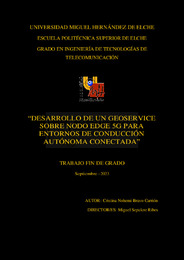Por favor, use este identificador para citar o enlazar este ítem:
https://hdl.handle.net/11000/31623Registro completo de metadatos
| Campo DC | Valor | Lengua/Idioma |
|---|---|---|
| dc.contributor.advisor | Sepulcre, Miguel | - |
| dc.contributor.author | Bravo Carrión, Cristina Nohemi | - |
| dc.contributor.other | Departamentos de la UMH::Ingeniería de Comunicaciones | es_ES |
| dc.date.accessioned | 2024-03-01T08:42:34Z | - |
| dc.date.available | 2024-03-01T08:42:34Z | - |
| dc.date.created | 2023-09 | - |
| dc.identifier.uri | https://hdl.handle.net/11000/31623 | - |
| dc.description.abstract | En un mundo en constante evolución tecnológica, la digitalización y la movilidad están redefiniendo el sector del transporte. Esta transformación se ve impulsada por una creciente conciencia sobre la necesidad de sistemas de transporte más eficientes, seguros y sostenibles con el medio ambiente. En este contexto, los Sistemas de Transporte Inteligentes Cooperativos (C-ITS) están emergiendo como una solución clave, ofreciendo la posibilidad de optimizar el flujo de tráfico y responder adecuadamente a situaciones de peligro, lo cual requiere de una alta coordinación entre los diferentes elementos que componen el sistema de transporte. Los sistemas C-ITS se basan en tecnologías de comunicaciones móviles e inalámbricas que permiten la comunicación directa entre vehículos (V2V, Vehicle-to-Vehicle) y entre vehículos e infraestructura (V2I, Vehicle-to-Infrastructure), o más conocido como V2X (Vehicle-to-Everything). Sin embargo, la generación de redes móviles 5G promete mejoras significativas en velocidad y latencias al combinarse con otras tecnologías como el computing. Estas comunicaciones son especialmente relevantes en el contexto de vehículos autónomos conectados, los cuales no solo están revolucionando la forma en que nos desplazamos, sino que también potencian la seguridad y la eficiencia en nuestras carreteras. La capacidad de estos vehículos para intercambiar información en tiempo real con otros vehículos e infraestructuras viales, facilitada por la tecnología 5G, es fundamental para prevenir accidentes y optimizar flujos de tráfico. Frente a este panorama, el presente proyecto de fin de grado se centra en abordar un aspecto clave en el ámbito de los C-ITS y los vehículos autónomos conectados: la difusión geolocalizada y selectiva de mensajes de alertas de tráfico, concretamente de mensajes DENM ( Messages). Por ello, el objetivo del proyecto es desarrollar un geoservice que permita una comunicación de alertas geolocalizada, contextualizada y estratégica. Por tanto, este servicio va a tener en cuenta la posición geográfica de los vehículos en relación con el evento de tráfico sucedido, asegurando que solo los vehículos directamente afectados o en riesgo inminente reciban la notificación pertinente. Este enfoque no solo optimiza la respuesta a situaciones críticas, sino también el volumen de tráfico en las redes de comunicación al eliminar mensajes redundantes o irrelevantes. De esta manera, el sistema contribuye a un uso más eficiente de los recursos de red y fortalece la confiabilidad en los vehículos autónomos conectados. | es_ES |
| dc.description.abstract | In a world in constant technological evolution, digitalization and mobility are redefining the transportation sector. This transformation is driven by a growing awareness of the need for more efficient, safer and environmentally sustainable transportation systems. In this context, Cooperative Intelligent Transportation Systems (C-ITS) are emerging as a key solution, offering the possibility to optimize traffic flow and respond appropriately to hazardous situations, which requires high coordination between the different elements that make up the transportation system. C-ITS systems are based on mobile and wireless communications technologies that enable direct communication between vehicles (V2V, Vehicle-to-Vehicle) and between vehicles and infrastructure (V2I, Vehicle-to-Infrastructure), or better known as V2X (Vehicle-to-Everything). However, the 5G generation of mobile networks promises significant improvements in speed and latencies when combined with other technologies such as edge computing. These communications are especially relevant in the context of connected autonomous vehicles, which are not only revolutionizing the way we get around, but also boosting safety and efficiency on our roads. The ability of these vehicles to exchange information in real time with other vehicles and road infrastructures, facilitated by 5G technology, is essential to prevent accidents and optimize traffic flows. Against this backdrop, this final degree project focuses on addressing a key aspect in the field of C-ITS and connected autonomous vehicles: the geolocalized and selective dissemination of traffic alert messages, specifically DENM (Decentralized Environmental Notification Messages) messages. Therefore, the objective of the project is to develop a geoservice that allows a geolocalized, contextualized and strategic communication of alerts. This service will therefore consider the geographical position of vehicles in relation to the traffic event, ensuring that only vehicles directly affected or at imminent risk receive the relevant notification. This approach not only optimizes the response to critical situations, but also the volume of traffic on the communication networks by eliminating redundant or irrelevant messages. In this way, the system contributes to a more efficient use of network resources and strengthens reliability in connected autonomous vehicles. | es_ES |
| dc.format | application/pdf | es_ES |
| dc.format.extent | 83 | es_ES |
| dc.language.iso | spa | es_ES |
| dc.publisher | Universidad Miguel Hernández de Elche | es_ES |
| dc.rights | info:eu-repo/semantics/openAccess | es_ES |
| dc.rights | Attribution-NonCommercial-NoDerivatives 4.0 Internacional | * |
| dc.rights.uri | http://creativecommons.org/licenses/by-nc-nd/4.0/ | * |
| dc.subject | digitalización | es_ES |
| dc.subject | movilidad | es_ES |
| dc.subject | transporte | es_ES |
| dc.subject | medio ambiente | es_ES |
| dc.subject | C-ITS | es_ES |
| dc.subject.other | CDU::6 - Ciencias aplicadas::62 - Ingeniería. Tecnología | es_ES |
| dc.title | Desarrollo de un geoservice sobre Nodo Edge 5G para entornos de conducción autónoma conectada | es_ES |
| dc.type | info:eu-repo/semantics/bachelorThesis | es_ES |

Ver/Abrir:
TFG-Bravo Carrión, Cristina Nohemi.pdf
3,82 MB
Adobe PDF
Compartir:
 La licencia se describe como: Atribución-NonComercial-NoDerivada 4.0 Internacional.
La licencia se describe como: Atribución-NonComercial-NoDerivada 4.0 Internacional.
.png)